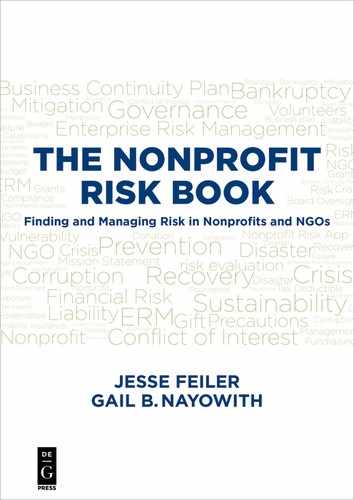About the Book
The book offers a lens through which to think about and manage risk along with a simple toolkit to do so. The idea is to take the guesswork out of risk assessment and mitigation planning so nonprofit executives and boards don’t have to learn how to manage risk at the worst possible time—through a critical incident or disastrous circumstance. It is our contention that just like a focus on insuring quality programming and managing performance, enterprise risk management (ERM) is a skill set that should be in every nonprofit leader’s repertoire.
Part I: Nonprofit Risk and Mitigation
2.Getting Started with Enterprise Risk Management
3.Risk Mitigation Plan Development & Monitoring
Part II: Nonprofit Operating Risk
7.Environment, Regulatory, and Compliance Issues
This book has two parts. In the first, we talk about the nature of nonprofit and nongovernmental organizations and speak to the risks all nonprofits face. We offer a simple taxonomy to help orient you to risk and ways to assess vulnerability and risk. We offer a way to prioritize risks and develop mitigation strategies tailored to your organization’s unique circumstances. We offer an orientation to the techniques of enterprise risk management. We want to leave executives and boards with a working ability to create an ERM plan and mitigation strategy and build an ERM system that can catch, filter, and address vulnerabilities before they turn into problems in your organization.
The message from the first half of the book includes one universal truth—that risk occurs in every nonprofit and risk can emerge in any nonprofit activity—and ten takeaways:
- Risk can be exacerbated or abated by organizational policies, practices, processes, people and technology platforms.
- Sometimes a risk is so flagrant and obvious it is shocking that it has gone unnoticed, and because it hasn't been dealt with, the risk has created dysfunction that has bled into every aspect of the organization's programs and operations.
- There is an interaction effect between risk and poor management where sleepy management, fuzzy management roles and a shaky decision-making hierarchy is the root cause of serious organizational risk.
- There is an interaction linking risk and governance where sleepy governance, inconsistent oversight, role confusion and/or troubled communication is at the root of risk in the organization.
- Weak business process, lack of formalized policies, limited training and inconsistent supervision to reinforce good practice often interact to create risk.
- Risk management enhances, and is no substitute for, strategic planning, corporate compliance, quality assurance or performance management activities in an organization.
- Organization size and complexity factor into an organization’s ability to withstand serious risks.
- Reliance on poorly paid staff and volunteers is a special challenge for nonprofit organizations.
- The nonprofit business model and reliance on government contracts and fundraising revenue breeds risk.
- Nonprofit risk, while akin to commercial business risk, has unique features that require tailored risk identification strategies and specialized mitigation solutions.
Looking at risk from different perspectives rather than from one view point can help you understand and be comfortable with the complexity you are looking at. In Part I, we show you several perspectives to help you think flexibly about the project you are undertaking.
In the second part of the book, we delve into the functional areas of nonprofit operations from programs and personnel to fundraising and governance. These chapters cover risk, risk clusters and risk interactions in key areas of nonprofit operations that, left unattended, can interrupt services or seriously derail operations and your attention to mission.
We don’t write about specific organizations or individuals—this is not a book of case studies—but about risk and vulnerabilities as recurring themes that we have observed time and again in our own work. While examples touch on all areas of nonprofit risk, we don’t limit discussion to topics covered elsewhere by colleagues in the insurance, audit, finance or legal services businesses. Our examples come from lived experience and are intended to prime your thinking, prompt action and make you shake your head. Our slant offers a window into some hard to believe and some not-at-all hard to believe nonprofit risks. The idea is that before dismissing any of the risk situations presented as something that cannot happen in your organization, we want you to stop and think about some of the mundane and outlandish things that come across your desk every day, those that you deal with routinely as a matter of course, and imagine what would happen if you hadn't dealt with them.
In addition to authoring this book, we now approach the issues of nonprofit risk in our consulting work and in The Nonprofit Risk App, a new tool we developed to make risk identification and risk management easier. It is available for iPhone and iPad in the App Store at http://apple.co/2fUXZqw. You can also use the downloadable PDF forms we have posted on our website at champlainarts.com/nprisk.
We encourage you to make space in your organization for risk assessment and management using whatever tools will work best for yourself and your organization: this book, the app, the literature on nonprofit risk, and/or an engagement with a consultant or firm. We conclude by cheering on all efforts to locate and address risk in nonprofit organizations that matter to you.
Notwithstanding all the help and assistance we have received from so many people, any errors are ours.
Feel free to contact us at [email protected].
